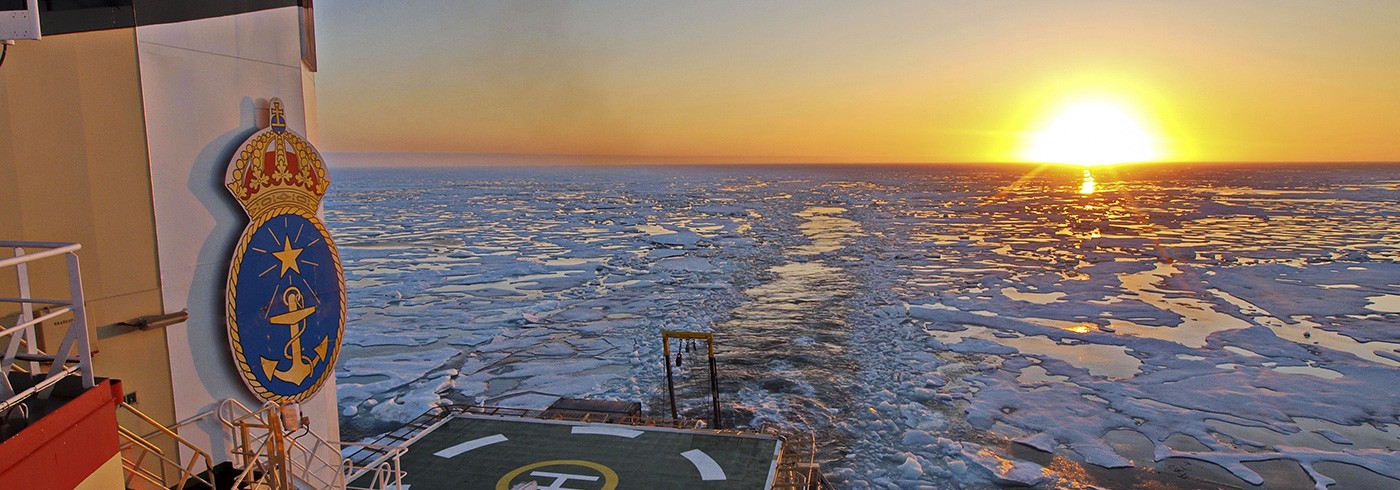We are observing and investigating methane releases on the East Siberian Arctic Ocean. For 72 hours now, we have been in the thick of extensive investigations of methane releases from the outer Laptev Sea system. The SWERUS-C3 expedition is really well equipped to detect the release of methane. As we steam along, we continuously measure methane levels in air, via inlets placed at a new meteorology mast at the very bow of the Oden, and in surface seawater, through a specially-constructed seawater intake (delivering water from an intake at 8 m depth underneath the hull of Oden directly to the permanent shipboard laboratory).
The air and seawater methane concentrations are probed in near real-time by advanced laser spectrometry techniques. We also use the Kongsberg acoustics system permanently installed on the Oden. This system has three key components; (1) a multibeam echosounder, providing detailed mapping of the water depth and of structures on the ocean floor; (2) a chirp sub-bottom profiler, providing information on sediment features down to tens of meters depth into the ocean bottom; and (3) a mid-water sonar (similar to a “fish finder”), providing information on e.g. gas bubbles rising through the entire water column. As the Oden makes a stop, at a so-called “station”, an extensive seawater and sediment sampling program starts. This involves getting water onboard in CTD-Niskin bottles from up to 24 different depths. Then, some 20 different chemical components in the seawater are measured, some even already onboard.
We measure the spatial distribution of methane concentration directly in board. We also measure concentration of ethane, as the methane/ethane ratio gives us a first indication of the relative importance of decaying drowned wetlands/permafrost (so-called biogenic as bacterial breakdown produces the methane) vs a deeper petroleum/natural gas (so-called thermogenic) source. Samples are also analysed onboard for nutrients, dissolved organic carbon, alkalinity, pH, dissolved inorganic carbon and for other gases such as carbon dioxide, nitrous oxide, hydrogen and oxygen. Importantly, samples are also taken for advanced post-cruise analysis in our shorebased laboratories for e.g. the triple isotopic composition of methane (stable C and H isotopes and the radiocarbon/14C signal), which carries strong diagnostic information regarding both the sources (biogenic vs thermogenic) and extent of microbial degradation of dissolved methane. We will also analyze the He and Ra isotopes, which will indicate the extent of active deep conduits for gas releases from the sediments.
At a station, we also collect sediment samples for methane, methane isotopes, organic geochemical studies of the carbon cycle, particularly what happens to the old carbon released via rivers and coastal erosion due to thawing land-based permafrost pools.
So, what have we found in the first couple of days of methane-focused studies?
1) Our first observations of elevated methane levels, about ten times higher than in background seawater, were documented already as we climbed up the steep continental slope at stations in 500 and 250 m depth. This was somewhat of a surprise. While there has been much speculation of the vulnerability of regular marine hydrates (frozen methane formed due to high p and low T) along the Arctic rim, very few actual observations of methane releases due to collapsing Arctic upper slope marine hydrates have been made. ¨
It has recently been documented that a tongue of relatively varm Atlantic water, with a core at depths of 200–600 m may have warmed up some in recent years. As this Atlantic water, the last remnants of the Gulf Stream, propagates eastward along the upper slope of the East Siberian margin, our SWERUS-C3 program is hypothesizing that this heating may lead to destabilization of upper portion of the slope methane hydrates. This may be what we now for the first time are observing.
2) Using the mid-water sonar, we mapped out an area of several kilometers where bubbles were filling the water column from depths of 200 to 500 m. During the preceding 48 h we have performed station work in two areas on the shallow shelf with depths of 60-70m where we discovered over 100 new methane seep sites. SWERUS-C3 researchers have on earlier expeditions documented extensive venting of methane from the subsea system to the atmosphere over the East Siberian Arctic Shelf. On this Oden expedition we have gathered a strong team to assess these methane releases in greater detail than ever before to substantially improve our collective understanding of the methane sources and the functioning of the system. This is information that is crucial if we are to be able to provide scientific estimations of how these methane releases may develop in the future.
The weather Gods are still on our side as we steam through a now ice-free Laptev Sea under a light cloud cover and with moderate winds.

